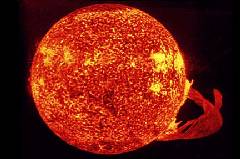|
VI. THE SOLAR SYSTEM
Our own neighborhood consists of a small star system we call the Solar
System* that consists of a half a dozen types of bodies: a star, planets
and their moons**, asteroids, comets, gas and dust.
A. The sun, the closest star.
Vital statistics:
| Average distance from Earth |
93x106 miles; 150x106 km; 1AU; 8.3
L(ight)M(inutes) |
| Angular diameter (from earth) |
0.53o; 32 arc minutes |
| Period of Rotation |
25 days @ equator |
| Diameter |
1.4x106 km; 865,000 mi; 108 earth diams. |
| Density |
1.41 g/cm3 |
| Surface temp |
5800K |
| Core Temp. |
~15x106K |
| Spectral Class |
G2 |
| Luminosity Class |
V (main sequence star) |
| Mass |
99.85% of solar system mass; 1.3x106 earth masses |
.
 Although the
sun is a smallish average star, it is by far the largest object in the
solar system. It is the brightest star in the sky (apparent visual magnitude:-26.7)
simply because it is so close. Stars are unique in that they generate their
own light and energy. In the last century, before atoms were understood,
it was variously argued that the sun was shining from gravitational contraction,
chemical reactions, asteroid impact, etc. Today we know that the sun releases
the large majority of its energy by fusing (combining) nuclei of hydrogen
to make helium. In this process, a small amount of mass is converted into
energy. This mass/energy relationship is described in the famous E=mc2
equation. Every second, in its core, the sun converts some 4 million tons
of matter into energy. All other objects in the solar system, such as the
planets, moons and comets, only glow from the reflected*** light of the
sun. Although the
sun is a smallish average star, it is by far the largest object in the
solar system. It is the brightest star in the sky (apparent visual magnitude:-26.7)
simply because it is so close. Stars are unique in that they generate their
own light and energy. In the last century, before atoms were understood,
it was variously argued that the sun was shining from gravitational contraction,
chemical reactions, asteroid impact, etc. Today we know that the sun releases
the large majority of its energy by fusing (combining) nuclei of hydrogen
to make helium. In this process, a small amount of mass is converted into
energy. This mass/energy relationship is described in the famous E=mc2
equation. Every second, in its core, the sun converts some 4 million tons
of matter into energy. All other objects in the solar system, such as the
planets, moons and comets, only glow from the reflected*** light of the
sun.
* The name is derived from Sol the Latin name for the Sun
** Technically and correctly there is only one moon and that's ours.
All others are called natural satellites.
*** Comets actually also fluoresce on their close approach to the sun |





